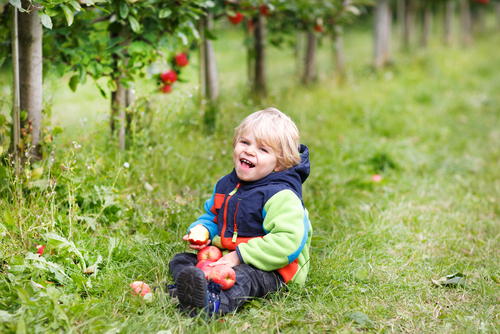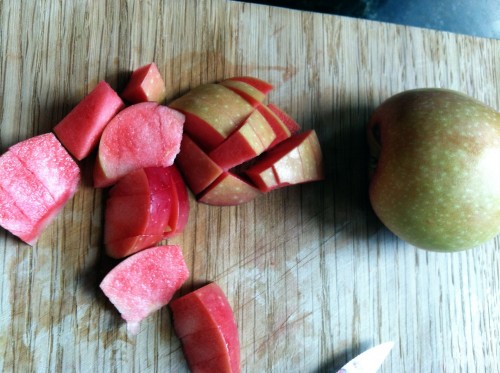 Growing up, I hated red apples. The grocery store specimens, which were always Red Delicious, looked pretty in the grocery bin, but their perfect skin tasted slightly bitter, their flesh bland and mealy. I didn’t mind varieties like Yellow Delicious, Granny Smiths, or Galas, but they still provided too little flavor to evoke desire.
Growing up, I hated red apples. The grocery store specimens, which were always Red Delicious, looked pretty in the grocery bin, but their perfect skin tasted slightly bitter, their flesh bland and mealy. I didn’t mind varieties like Yellow Delicious, Granny Smiths, or Galas, but they still provided too little flavor to evoke desire.
I considered the apple a durable and highly acceptable snack — something to stash in my jersey pocket during a long bike ride or my backpack for a long day at the lab. Chopped up and cooked with cinnamon in my oatmeal or baked with butter and brown sugar in a crisp, a Granny Smith or Yellow Delicious could transform into something resembling a treat, but they were never a food whose mere mention could make my mouth water.
So when my husband and I bought a small farm nine years ago, I eagerly awaited the fruits of the property’s apricot trees, while almost overlooking the half dozen aging apples trees in our front yard. These trees were all the more easy to dismiss because these once-heralded varieties — Red and Yellow Delicious — were no longer chic.
It wasn’t until I bit into a Red Delicious apple, just plucked from the tree, that I realized how little the grocery store variety resembled a fresh, tree-ripened fruit. Eaten at its peak, and without added wax, the Red Delicious gives cause for its name. Sure, it’s no Honeycrisp, but a Red Delicious at its prime has a crisp, mild flesh without a hint of bitterness or that stale, cardboard mouth feel that hinders the ones on store shelves. Its flavor is sweet, but not sappy. Likewise, the fruits of our old time Golden Delicious tree have a satisfyingly crisp pulp and a honey-like sweetness to them.
 Had I never tried these fruits direct from the tree, I wouldn’t have known how close I’d come to dismissing them without ever experiencing the fruits in their natural setting. It’s a stern reminder of how, when the things we consume become large-scale commodities, they can lose their context and authenticity.
Had I never tried these fruits direct from the tree, I wouldn’t have known how close I’d come to dismissing them without ever experiencing the fruits in their natural setting. It’s a stern reminder of how, when the things we consume become large-scale commodities, they can lose their context and authenticity.
In the era of the 24/7 grocery story, we no longer eat based on the seasons. You can buy an apple any month of the year, and the tree that it came from may lie hundreds or even thousands of miles away. If you’re lucky, that fruit was picked recently, but it’s possible that it came from a warehouse where it was kept cold for weeks or months, waiting for an opening in the market.
Each October, my little western Colorado town hosts a celebration called Apple Fest. A generation ago, apple orchards covered our verdant valley. Today, most of those orchards are gone, and our local grocery store stocks apples grown three states away. Google the word apple, and most of the images that come up involve a certain brand of computer, with nary an edible fruit in view.
But the thing itself has yet to disappear. In our own little orchard, we’ve planted more than six apple varieties, including my current favorite — the Mountain Rose red flesh apple. The small commercial orchards around here still sell old time varieties like Cox’s Orange Pippin, Ashmead’s Kernels, Freyburgs, Pitmaston Pineapples, and Hubbardson’s Nonesuchs, along with more recent favorites like Ginger Golds, Fujis, Jonagolds and Honeycrisps.
After nearly a decade of living amid trees that bear delicious fruits from June through October, the pleasure of walking through a field of flavor, plucking a gem from the tree and biting into its luscious flesh has become second nature. How sad to remember the years I lived without knowing this joy.
*Top Image by Shutterstock. Mountain Rose apple photo by Christie Aschwanden.
Love this, Christie. And it describes my evolution as an apple eater well. We’ve got a red delicious apple tree and a macintosh tree in our suburban front yard. And this fall, they are both producing like crazy!
I feel the same way about tomatoes. Growing up in the American South, they were frequently one of the side dishes at the main meal. But those were grown in the cook’s back yards. I won’t buy a tomato at the store. Instead, I grown heirloom varieties suited for my local climate. As someone in a tomato growing forum likes to say, “I never met a tomato I didn’t like, until I bought one in the grocery store.”
We moved to New Brunswick Canada in October 2005, eight years ago, from a small (22ac) hobby farm in north Alabama.
The apples here have been an amazing discovery for me … some (the Cortland comes to mind) I’ve eaten for the first time in my life.
It was very difficult to get good apples in the South, or local … most grocery stores carry (always) the red delicious that I hated, usually mushy flesh, and I had to scrape the wax off them; and they usually carried the golden delicious variety, which never looked as pretty, but had a better taste; neither ever anything CLOSE to fresh.
Here, I buy locally what’s in season, and live near two large orchards. Here’s one … http://www.vergerbelliveauorchard.ca/en/apples/apple_varieties/ check the varieties of apples they grow!
I loved reading about your apple wisdom. In supermarkets in Ukraine, where I live, you can buy pretty, imported apples. Or you can buy local ones, which have spots, crevices, bruises and other imperfections. But if you have the courage to bite into a local apple, your reward is rich.
Is your little town Lakewood? They just had Cider Days earlier this month.